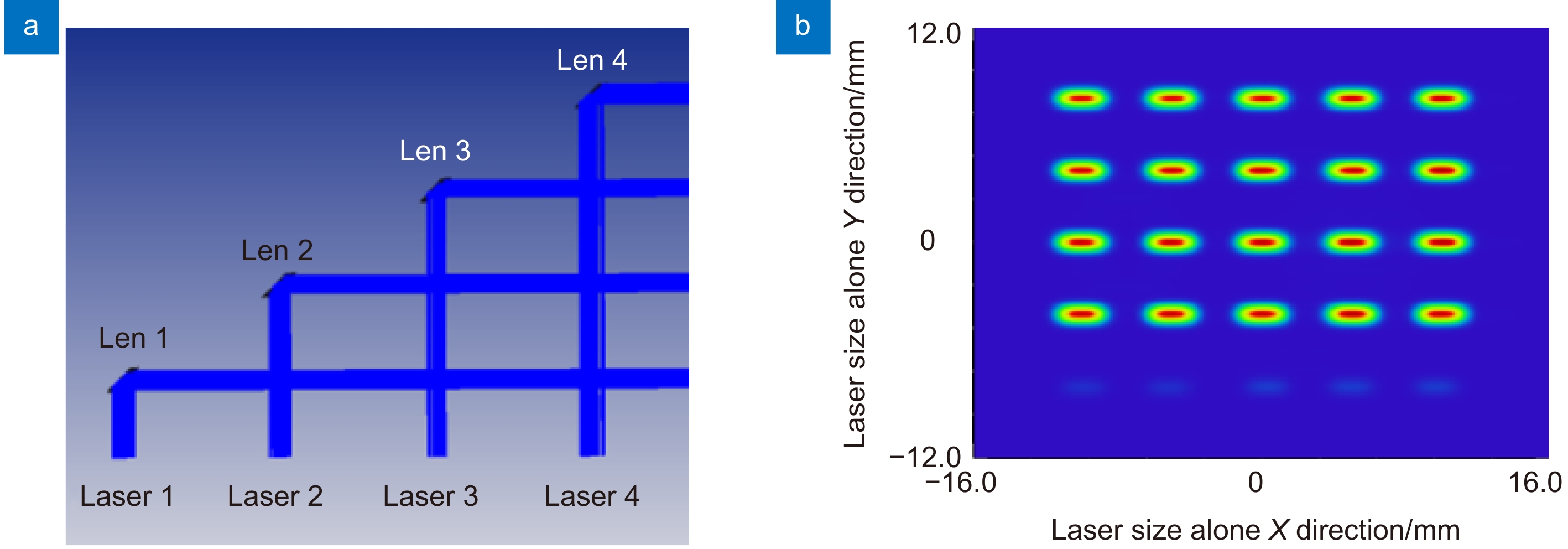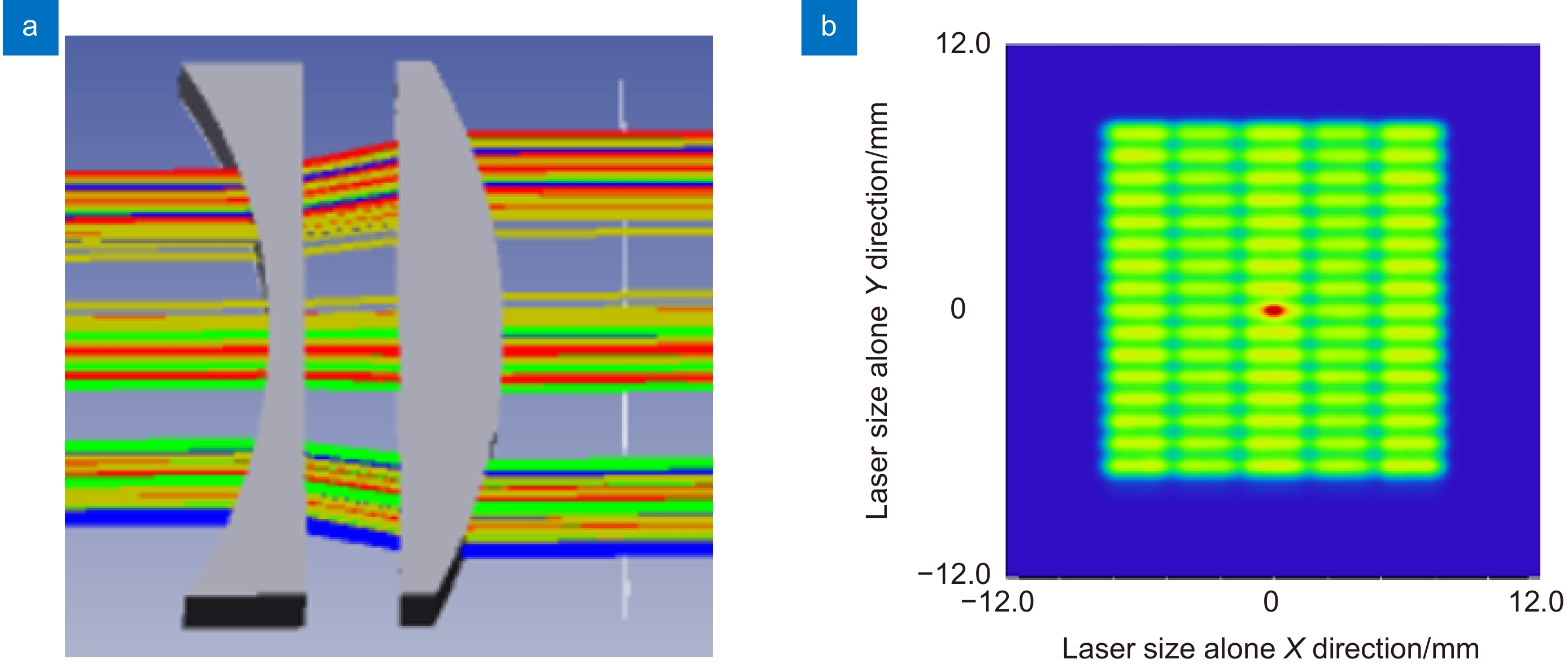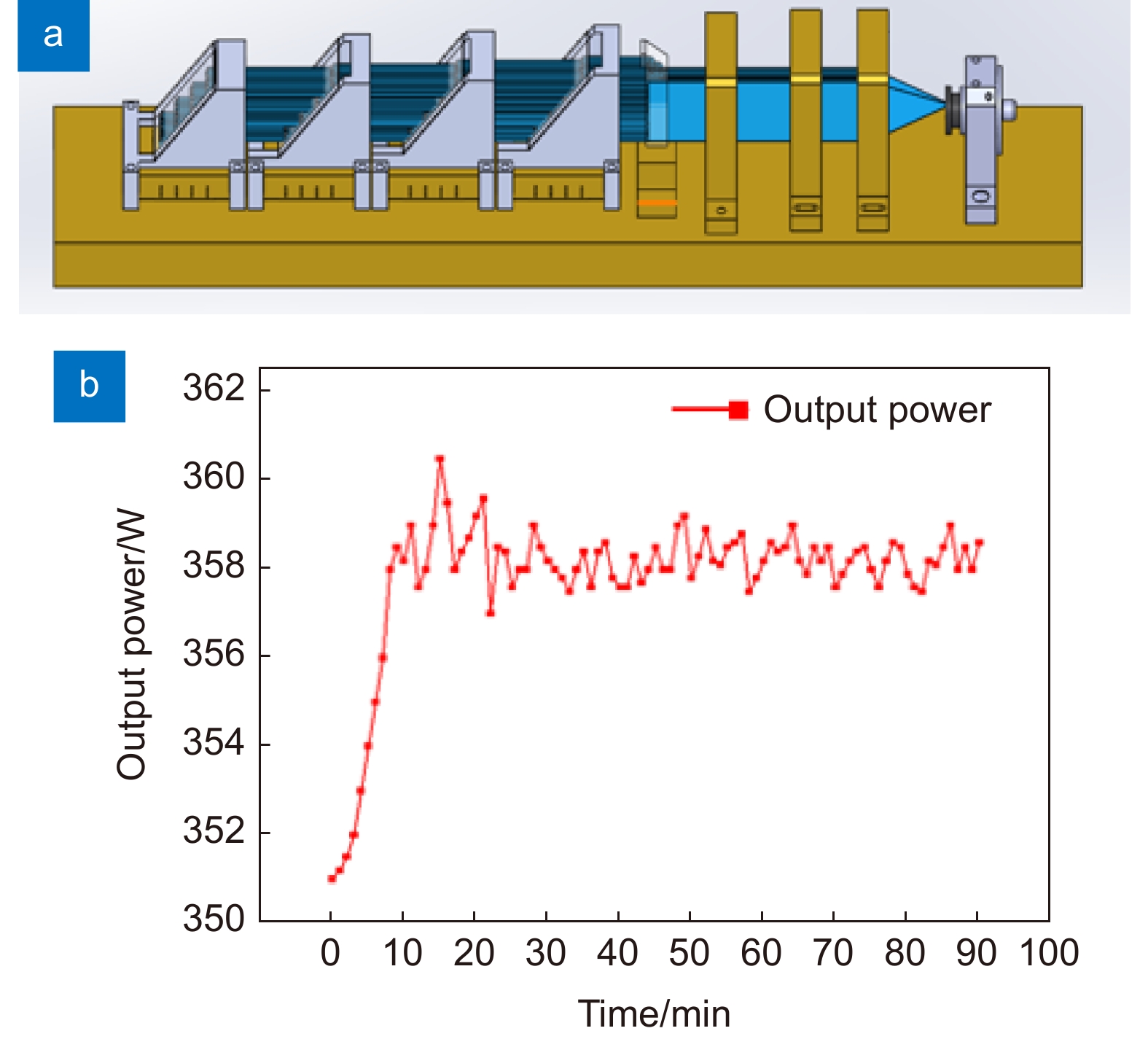Research on the beam combining technique of a 350 W blue semiconductor laser for urological applications
-
摘要:
泌尿外科临床激光治疗的传统光源主要是掺铥激光、掺钬激光和掺钕倍频绿激光等。近年来,随着蓝光半导体激光单管功率逐渐提升,450 nm蓝光逐步被应用于膀胱肿瘤切除手术,具有切割干净、出血少、邻近组织无不良凝血等特点。本文针对泌尿外科应用所急需的高稳定性光纤耦合输出的蓝光激光器需求,研究了350 W光纤耦合蓝光半导体激光器,采用4个100 W阵列式蓝光单元作为光源,分析了多发光点阵列的光场传输特性,光强远场分布为双峰结构,峰值角为${\arcsin}(5\lambda /4{\gamma }_{{\rm{d}}})$;基于空间合束技术,实现慢轴光束交叉叠加,消除发光死区;使用偏振合束技术,让一束光的偏振态由P光变为S光后与另一束P光垂直叠加,实现快轴光束的间距压缩,提高光束亮度;准直结构分别将光束快慢轴发散角缩小为0.6981 mrad和1.0123 mrad,快轴用1.2倍扩束系统将输出光斑变换为正方形。研究结果表明,所研发的激光器蓝光功率为358 W,输出光纤200 μm/NA 0.22,合束效率为89.5%,电光转换效率31.3%,功率波动小于0.4%。选用通水光纤作为输出端,为泌尿外科临床治疗提供了更高功率的激光医疗方案。
Abstract:The main light sources used in the clinical treatment of urological surgery are thulium-doped laser, holmium-doped laser, and green laser via the double-frequency from neodymium-doped laser, etc. In recent years, with the improvement of the output power of blue semiconductor laser diodes, 450 nm blue light has attracted growing attention and been applied in bladder tumor resection surgery, offering advantages such as clean cutting, minimal bleeding, and no adverse coagulation of adjacent tissues. This work focuses on the solution for a high-stability fiber-coupled output blue laser source for urological surgery applications. A 350 W fiber-coupled blue semiconductor laser is built by utilizing four 100 W arrayed blue laser units as the light source. The optical field transmission characteristics of the multi-emitter array are analyzed, and the far-field distribution of optical intensity exhibits a dual-peak structure with a peak angle of ${\arcsin}(5\lambda /4{\gamma }_{{\rm{d}}})$. By applying the spatial beam combining technique, we have successfully achieved the cross-interference of the slow-axis beams, thereby obliterating the emission dead zone. A polarization beam combining scheme is performed to rotate the polarization state of one beam from P-polarized to S-polarized, and then combine it orthogonally with another P-polarized beam, resulting in compression of the spacing between fast-axis beams and improved beam brightness. The collimating structure reduces the divergence angles of the fast and slow axes to 0.6981 mrad and 1.0123 mrad, respectively. The fast axis is expanded by a factor of 1.2 to transform the output beam profile into a square shape. Finally, we obtain a blue laser with a power of 358 W, an output fiber of 200 μm/NA 0.22, a beam combining efficiency of 89.5%, an electro-optical conversion efficiency of 31.3%, and power fluctuation less than 0.4%. Using the water-cooled fiber to couple out the light beam, this high-power laser source may serve as an ideal medical solution for clinical treatment in urological surgery.
-
Key words:
- laser technology /
- laser clinical applications /
- blue lasers /
- beam combination /
- high-stability
-
Overview: The main light sources used in the clinical treatment of urological surgery are thulium-doped laser, holmium-doped laser, and green laser via the double-frequency from neodymium-doped laser, etc. In recent years, with the improvement of the output power of blue semiconductor laser diodes, 450 nm blue light has attracted growing attention and been applied in bladder tumor resection surgery, offering advantages such as clean cutting, minimal bleeding, and no adverse coagulation of adjacent tissues. This work focuses on the solution for a high-stability fiber-coupled output blue laser source for urological surgery applications. A 350 W fiber-coupled blue semiconductor laser is built by utilizing four 100 W arrayed blue laser units as the light source. The optical field transmission characteristics of the multi-emitter array are analyzed, and the far-field distribution of optical intensity exhibits a dual-peak structure with a peak angle of arcsin(5λ /4γd). By applying the spatial beam combining technique, we have successfully achieved the cross-interference of the slow-axis beams, thereby obliterating the emission dead zone. A polarization beam combining scheme is performed to rotate the polarization state of one beam from P-polarized to S-polarized, and then combine it orthogonally with another P-polarized beam, resulting in compression of the spacing between fast-axis beams and improved beam brightness. The collimating structure reduces the divergence angles of the fast and slow axes to 0.6981 mrad and 1.0123 mrad, respectively. The fast axis is expanded by a factor of 1.2 to transform the output beam profile into a square shape. The final research findings demonstrate that:
1) Based on 100 W arrayed blue laser units, we have successfully implemented spatial beam combining and polarization beam combining techniques, resulting in a significant reduction in the dead zone of the beam and a substantial increase in the output power density. Ultimately, we have successfully combined the beams from four 100 W arrayed blue laser units to achieve a beam size of 13.3 mm×16.4 mm.
2) After beam combining, we have successfully coupled the beam into a 200 μm optical fiber using techniques such as beam expansion and focusing. As a result, we achieved a stable output power of 358 W for the blue laser, with a beam coupling efficiency of 89.5% and an electro-optical conversion efficiency of 31.3%.
3) The laser operates with remarkable stability, exhibiting power fluctuations of less than 2.4%. The brightness and beam quality of the output beam are both exceptionally high. Furthermore, the output power of 350 W surpasses that of any known blue laser medical device currently available on the market, making it suitable for clinical treatments in urological surgery.
-

-
图 3 慢轴空间合束过程。(a)空间合束结构;(b)实物结构;(c)双单元合束后光斑;(d)三单元合束后光斑;(e)四单元合束后光斑
Figure 3. Process of spatial beam combining in the slow axis. (a) Spatial beam combining structure;(b) Physical structure;(c) Spot after double-unit beam combining;(d) Spot after three-unit beam combining;(e) Spot after four-unit beam combining
表 1 阵列式蓝光单元的结构参数
Table 1. Structure parameters of arrayed blue light units
Parameter Typ. Unit Central wavelength 447 nm Output power 100 W Emitter spatial period (∥) 1.4 mm Emitter spatial period (⊥) 3.2 mm Number of emitters (∥) 4 — Number of emitters(⊥) 5 — Slow axis divergence <1.0123 mrad Fast axis divergence <0.6981 mrad Polarization TE(>97%) — -
[1] 曾庆栋, 袁梦甜, 朱志恒, 等. 便携式激光诱导击穿光谱最新研究进展[J]. 中国光学, 2021, 14(3): 470−486. doi: 10.37188/CO.2020-0093
Zeng Q D, Yuan M T, Zhu Z H, et al. Research progress on portable laser-induced breakdown spectroscopy[J]. Chin Opt, 2021, 14(3): 470−486. doi: 10.37188/CO.2020-0093
[2] 闵欢欢, 刘广华, 翟学君, 等. 单掺钬固体激光器的研究进展[J]. 激光与光电子学进展, 2022, 59(21): 2100002. doi: 10.3788/LOP202259.2100002
Min H H, Liu G H, Zhai X J, et al. Research progress of single-doped holmium solid-state lasers[J]. Laser Optoelectron Prog, 2022, 59(21): 2100002. doi: 10.3788/LOP202259.2100002
[3] 孙有生, 端木庆铎, 林鹏, 等. 1.6 μm波段锁模光纤激光器[J]. 中国光学, 2021, 14(6): 1387−1394. doi: 10.37188/CO.2021-0128
Sun Y S, Duanmu Q D, Lin P, et al. 1.6 μm band mode-locked fiber laser[J]. Chin Opt, 2021, 14(6): 1387−1394. doi: 10.37188/CO.2021-0128
[4] Elshal A M, Elkoushy M A, El-Nahas A R, et al. GreenLightTM laser (XPS) photoselective vapo-enucleation versus holmium laser enucleation of the prostate for the treatment of symptomatic benign prostatic hyperplasia: a randomized controlled study[J]. J Urol, 2015, 193(3): 927−934. doi: 10.1016/j.juro.2014.09.097
[5] Misrai V, Kerever S, Phe V, et al. Direct comparison of GreenLight Laser XPS photoselective prostate vaporization and GreenLight laser en bloc enucleation of the prostate in enlarged glands greater than 80 ml: a study of 120 patients[J]. J Urol, 2016, 195(4 Pt 1): 1027−1032. doi: 10.1016/j.juro.2015.10.080
[6] Aldoukhi A H, Roberts W W, Hall T L, et al. Watch your distance: the role of laser fiber working distance on fragmentation when altering pulse width or modulation[J]. J Endourol, 2019, 33(2): 120−126. doi: 10.1089/end.2018.0572
[7] Elhilali M M, Badaan S, Ibrahim A, et al. Use of the moses technology to improve holmium laser lithotripsy outcomes: a preclinical study[J]. J Endourol, 2017, 31(6): 598−604. doi: 10.1089/end.2017.0050
[8] Winship B, Wollin D, Carlos E, et al. Dusting efficiency of the moses holmium laser: an automated in vitro assessment[J]. J Endourol, 2018, 32(12): 1131−1135. doi: 10.1089/end.2018.0660
[9] Martov A G, Ergakov D V, Guseinov M A, et al. Initial experience in clinical application of thulium laser contact lithotripsy for transurethral treatment of urolithiasis[J]. Urologiia, 2018(1): 112−120. doi: 10.18565/urology.2018.1.112-120
[10] Ulvik Ø, Æsøy M S, Juliebø-Jones P, et al. Thulium fibre laser versus holmium: YAG for ureteroscopic lithotripsy: outcomes from a prospective randomised clinical trial[J]. Eur Urol, 2022, 82(1): 73−79. doi: 10.1016/j.eururo.2022.02.027
[11] Jiang D L, Yang Z, Liu G X, et al. A novel 450-nm blue laser system for surgical applications: efficacy of specific laser-tissue interactions in bladder soft tissue[J]. Lasers Med Sci, 2019, 34(4): 807−813. doi: 10.1007/s10103-018-2668-5
[12] Xu X F, Jiang D L, Liu G X, et al. A novel 450 nm semiconductor blue laser system for application in colon endoscopic surgery: an ex vivo study of laser-tissue interactions[J]. Photobiomodul Photomed Laser Surg, 2019, 37(1): 25−30. doi: 10.1089/photob.2018.4531
[13] Yu H, Ma X H, Zou Y G, et al. Beam shaping design for fiber-coupled laser-diode system based on a building block trapezoid prism[J]. Opt Laser Technol, 2019, 109: 366−369. doi: 10.1016/j.optlastec.2018.08.030
[14] Lin G Y, Zhao P F, Dong Z Y, et al. Beam-shaping technique for fiber-coupled diode laser system by homogenizing the beam quality of two laser diode stacks[J]. Opt Laser Technol, 2020, 123: 105919. doi: 10.1016/j.optlastec.2019.105919
[15] Lin X C, Lin G Y, Zhao P F, et al. Generation of high brightness diode laser by using spectral and polarization beam combination[J]. Opt Laser Technol, 2019, 116: 219−223. doi: 10.1016/j.optlastec.2019.03.042
[16] Tian J Y, Zhang J, Peng H Y, et al. High power diode laser source with a transmission grating for two spectral beam combining[J]. Optik, 2019, 192: 162918. doi: 10.1016/j.ijleo.2019.06.018
[17] 刘斌. 高功率半导体激光器阵列外腔波长锁定研究及器件研制[D]. 西安: 中国科学院大学(中国科学院西安光学精密机械研究所), 2021. https://doi.org/10.27605/d.cnki.gkxgs.2021.000009.
Liu B. Research on high-power wavelength locking external cavity diode laser array and device development[D]. Xi’an: University of Chinese Academy of Sciences (Xi'an Institute of Optics and Precision Mechanics of CAS), 2021. https://doi.org/10.27605/d.cnki.gkxgs.2021.000009.
[18] Wang Z L, Drovs S, Segref A, et al. Fiber coupled diode laser beam parameter product calculation and rules for optimized design[C]//Proceedings of the SPIE 7918, High-Power Diode Laser Technology and Applications IX, San Francisco, 2011: 86–94. https://doi.org/10.1117/12.875386.
[19] Diehl R. High-power diode lasers: fundamentals, technology, applications: with contributions by numerous experts[M]. Berlin: Springer, 2000. https://doi.org/10.1007/3-540-47852-3
[20] Haas M, Rauch S, Nagel S, et al. Beam quality deterioration in dense wavelength beam-combined broad-area diode lasers[J]. IEEE J Quantum Electron, 2017, 53(3): 2600111. doi: 10.1109/JQE.2017.2686358
[21] 徐强. 半导体激光器光束传输特性研究[D]. 西安: 西安电子科技大学, 2007.
Xu Q. The beam propagation characteristics of semiconductor lasers[D]. Xi’an: Xidian University, 2007.
-


 E-mail Alert
E-mail Alert RSS
RSS

 下载:
下载:










